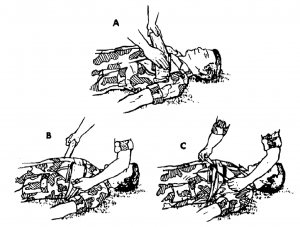Apply a dressing to secure and protect the seal and to absorb secretions.
Secure the dressing with a bandage. The following steps are for applying a field dressing to an improvised occlusive dressing.
a. Apply the Field Dressing.
(1) Pick up the packet containing the dressing.
(2) Grasp the packet with both hands and twist until the paper wrapper breaks.
(3) Remove the dressing from the wrapper and discard the wrapper. Avoid touching the white, sterile dressing pad and keep the pad as free from contamination as possible.
(4) Grasp the folded tails of the dressing with both hands, hold the dressing above the wound with the sterile pad toward the wound, and pull the tails so the dressing opens and flattens.
(5) Place the sterile dressing pad on top of the sealing material.
CAUTION: If an impaled object is protruding from the chest wound, apply a bulky dressing to the wound without covering or moving the object. Then stabilize the object by placing bulky dressings made from the cleanest material available around the protruding object.
b. Secure the Dressing.
Secure the dressing using the attached bandages.
The bandages must be tight enough to ensure the dressing will not slip, but not tight enough to interfere with the casualty’s breathing. If the casualty is able, have him hold the dressing in place while you secure it. If he cannot help, hold the dressing in place while securing it (figure 3-5 A).

(1) Grasp one tail, slide it under the casualty, bring it up the other side of the casualty, and bring it back over the dressing.
(2) Wrap the other tail around the casualty in the opposite direction (figure 3-5 B) and bring it back over the dressing.
(3) Tell the casualty to exhale and hold his breath. If the casualty is unconscious or cannot hold his breath, tie the knot after his chest falls and before the chest rises again.
(4) Tighten the tails and tie them with a non-slip knot over the center of the dressing (figure 3-5 C). Tying the knot over the middle of the dressing directly over the wound will provide additional pressure to the wound and will help to ensure a good seal against the influx of air.
CAUTION: If an object is protruding from the wound, apply additional bandages to hold the bulky dressings in place. Do not wrap the bandages around the protruding object. Tie the bandages in a nonslip knot beside the object, not on it.
(5) Have the casualty resume normal breathing.
c. Apply Additional Padding, If Needed.
Additional pressure and stability can be achieved by placing padding material or other dressings over the field dressing and securing the material with bandages, an elastic roller bandage, or the casualty’s belt. Make sure the padding and securing materials do not interfere with the casualty’s breathing.
